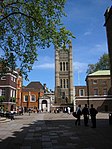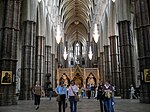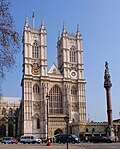Westminster Abbey Museum
1908 establishments in EnglandMuseums established in 1908Museums in the City of WestminsterReligious museums in EnglandUse British English from November 2015 ... and 1 more
Westminster Abbey
The Westminster Abbey Museum was located in the 11th-century vaulted undercroft beneath the former monks' dormitory in Westminster Abbey, London, England. This was located in one of the oldest areas of the Abbey, dating back almost to the foundation of the Romanesque church by Edward the Confessor in 1065. This space had been used as a museum since 1908.
Excerpt from the Wikipedia article Westminster Abbey Museum (License: CC BY-SA 3.0, Authors).Westminster Abbey Museum
Way of the Monks, London Millbank
Geographical coordinates (GPS) Address Phone number Website Nearby Places Show on map
Geographical coordinates (GPS)
| Latitude | Longitude |
|---|---|
| N 51.49876 ° | E -0.12753 ° |
Address
Westminster School
Way of the Monks
SW1P 3PF London, Millbank
England, United Kingdom
Open on Google Maps








